¶ 1 Leave a comment on paragraph 1 0 Welcome. Please read the instructions for reviewing before commenting. We ask contributors to be generous when thinking along with our pieces and to keep in mind that the final chapters are intended to be short essays. Visit matteringpress.org for more information on its other books. Readers might also want to have a look at this resource created by one of the book’s editors, Emily Yates-Doerr, which catalogues key Open Access anthropology publications.
¶ 2 Leave a comment on paragraph 2 0 By Melissa Biggs and John Bodinger de Uriarte
¶ 3 Leave a comment on paragraph 3 0 Cases set boundaries; cases draw you in. Often imagined as they appear in traditional museums – archipelagos of order in ordered spaces with carefully placed markers for larger narratives – cases partition, sequence, and present artifacts and information for visitor attentions. As anthropologists interested in museums and other exhibitionary spaces, we consider the parameters around what is encased and what is not encased. Where does the visitor experience of the museum actually begin, and how do you know?
¶ 4 Leave a comment on paragraph 4 1 Much of our work in recent years focuses on the establishment and expansion of public exhibition venues for Native American self-representations of histories and sovereignties, following the advent of Indian gaming.[i] Our research often oscillates between the realms of public stories presented in museums and at historical landmarks, and the kinds of public stories and thematics employed in casinos and spaces such as gardens, village greens, and hotel lobbies. For this project we visited casino and non-casino Native sites in Connecticut, Minnesota, and Southern California, and studied casino design in Macau and Las Vegas.
¶ 5 Leave a comment on paragraph 5 0 We seek to provoke certain kinds of reading spaces or experiences for the reader. One of the ways we see our writing working in this case is by evoking the kind of dense, overlaying, immersive experience that casinos offer. The images we provide are designed to be evocative; the way the text and the photos work together is part of our analysis.
¶ 6
Leave a comment on paragraph 6 0
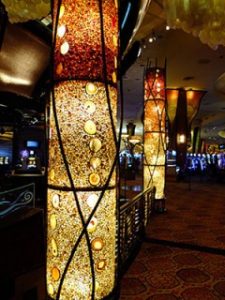
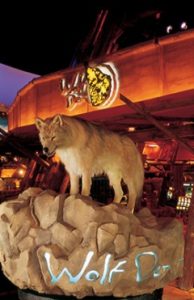
¶ 7 Leave a comment on paragraph 7 0 Our case in point here is the Mohegan Sun, in Uncasville, Connecticut. We choose this as our case of focus because it willfully blurs distinctions between casinos and more traditional exhibit spaces. Like all casinos, the design of the Mohegan Sun encloses its patrons within the casino space. The absence of windows, clocks, and a clear exit erases the outside and encourages people to stay in the building, to amble within a set of predetermined choices for attention or directed distraction.
¶ 8 Leave a comment on paragraph 8 1 The automated jingles of the slot machines, punctuated by the simulated sounds of coins spilling into their waiting troughs, promises potential gains. The noise distracts patrons and keeps them focused on the opportunities available within the casino confines, absorbed by the casino’s narrative. Visitors animate the interior, moving through the space, pushing buttons and turning cards—eating, walking, observing
¶ 9 Leave a comment on paragraph 9 1 Like most casinos, the Mohegan Sun serves up a thematic interpretation of a particular kind of nowhere, a site for generalized and accessible longing. Unlike most casinos, the Mohegan Sun draws on and accentuates a sense of place specifically connected to local imagined identities, what one might call a sense of “Moheganness.” The Mohegan Sun turns some of the thinking about casino interior design on its head by making design elements focal points for distracted attention, rather than rendering them unobtrusive, as in traditional casino design (cf Schull).[ii] Tribal historians worked with a casino design firm to embed a large number of Mohegan signs and symbols in the casino’s interior to create a space for “ambient learning.”[iii] This selective strategy renders other elements of Mohegan identities—like colonial and post-colonial histories of displacement and marginalization—invisible.[iv]
¶ 10
Leave a comment on paragraph 10 0


¶ 11 Leave a comment on paragraph 11 1 The Mohegan Sun presents an immersive experience that absorbs visitors into saturated interiors crammed with a dense set of Mohegan signs. These signs often intersect with those indicating an imagined “natural”: howling wolves, local plants and crops, stone formations, and starry skies. Some of this participates in recent casino design trends that extend fantastic narratives outside the confirming cases of their interior spaces. In Las Vegas, for example, the skyline and roller coaster of New York New York, and the hourly pirate battles at Treasure Island expand beyond the conventional limits of casino space. However, the imagined referents of many Las Vegas attractions lie far, far away from their footprints in that city. The Mohegan Sun’s outward-extending narratives are imagined both large and general, and profoundly local and intimate. The interior design at once effaces and hyper-refers to the outside. The inside folds outside to indicate its own surround, replete with local histories and desires. The interior design at once effaces and hyper-refers to the outside.
¶ 12
Leave a comment on paragraph 12 0


¶ 13 Leave a comment on paragraph 13 0 Patrons circulate through three interlocking gaming spaces, the Casinos of the Earth, Sky, and Wind. Each of the casinos functions as a contained narrative space. Within the Casino of the Earth, visitors move through the four seasons, signaled by the designs of the carpet—blooming flowers or autumnal leaves, for example—and skins printed with traditional seasonal activities, such as planting and hunting. The Mohegan creation story provides the central motif of the Casino of the Sky; the Casino of the Wind offers representations of the winds from the four directions. Some of these design elements immediately stand out. The printed skins suspended from the ceiling and the representations of the thirteen Mohegan moons embedded in the flooring need little explanation.
¶ 14 Leave a comment on paragraph 14 0 Other designs require more specialized knowledge: traditional basketry designs replicated by the light fixtures, the repetitions of certain color combinations and motifs that reproduce particular Mohegan symbols. To enable its visitors to engage with these less visible markers of Mohegan history and identity, the Mohegan Sun provides The Secret Guide “intended to facilitate and enrich” visitor experience “by explaining the hidden meaning of all that surrounds you at Mohegan Sun.” The guide links design choices to specific aspects of Mohegan cosmology, history, and traditional artistry. Once available for the asking at any of the information desks scattered throughout the casino and hotel complex, the guide must now be purchased in the casino gift shop.
¶ 15
Leave a comment on paragraph 15 0
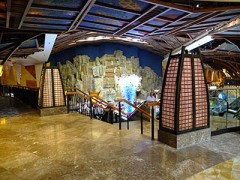

¶ 16 Leave a comment on paragraph 16 0 Each of the sign sets—the different motifs, the different objects, the different embedded narratives in the casino—whisper (or not) secret (or not) stories about imagined Mohegan spaces and places, groundings and elements. In a space made thick by noise and scent, sight, and the dense tactility of everywhere, jostling for over-layering attention, secret or silent stories weave through everything on display.
¶ 17 Leave a comment on paragraph 17 1 The Hall of the Lost Tribes, located in the Casino of the Earth, exemplifies the constant play between visible and invisible, real and imagined, Mohegan and not. The Hall pays homage to thirteen tribes that once occupied territories adjacent to the Mohegans with many of the tribal identifying symbols either taken from historical documents or created by the casino design firm. The Hall is fully enclosed, included in, but still separated from the Mohegan narrative.
¶ 18
Leave a comment on paragraph 18 0
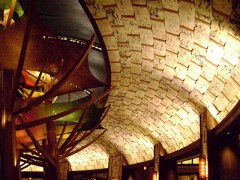
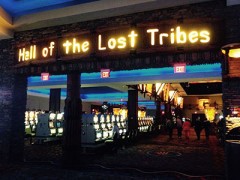
¶ 19 Leave a comment on paragraph 19 0 The immersive and multiply distracting interiors recall Walter Benjamin’s distraction theory, in particular its relationship to architecture. In contrast to the “contemplative immersion” demanded by traditional aesthetics, Benjamin posits that architecture offers “the prototype of an artwork that is received in a state of distraction and through the collective” (1968: 239).[v] While the concentration of the connoisseur allows for the artwork to absorb her, the distraction of “the masses” allows for their absorption of the artwork into themselves, a productive surrender to vernacular immersion.
¶ 20 Leave a comment on paragraph 20 0 The Mohegan Sun presents a grand distractive theater for such absorption. If the site blurs the distinctions between museum and casino it succeeds, in part, by oscillating between offering sites for contemplation and sites for traversing distraction—the kind of distraction achieved by walking through a space crammed full of Mohegan signs intermixed with the deep distractive strategies of a contemporary casino. The buzzing, ringing, flashing overloads approach a fully tactile atmosphere through which the patron swims, both enchanted and in a perpetual state of being decentered.
¶ 21
Leave a comment on paragraph 21 0
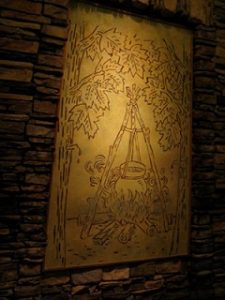
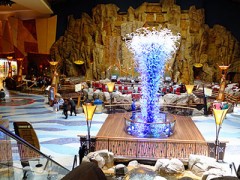
¶ 22 Leave a comment on paragraph 22 0 Building from Benjamin, Michael Taussig recognizes the “dialectical image” inherent in the mimetic faculty, “historicizing nature and naturalizing history.” Mimesis is “the nature that culture uses to create second nature…drawing on the character and power of the original” (1993: 251). While the interior case contains a complicated mix of explained and unexplained Mohegan referents and designs, the case’s exterior gestures outward, including and embracing the site as part of its sign. The mirrored, reflective glass exterior of much of the complex serves as a skin that replicates its surroundings, referring to a close elsewhere, covering itself with a mimetic landscape.
¶ 23 Leave a comment on paragraph 23 1 We present the Mohegan Sun as a case that troubles distinctions between representational and immersive environments. Writing a case study such as this encourages us to rethink the boundaries between public casino spaces and more traditional exhibition spaces, to recognize them as a continuum. This kind of writing permits a kind of “sense engagement” with the text, at once immersive and representational, drawing you into a story intended to feel expansive, but which remains carefully bounded. The surrounds of Uncasville and local histories bump against each other, the expectations of non-Native visitors looking for Native markers against a backdrop of the imagined Native mundane, and local uses of Mohegan stories and place- and way-finding practices. While the building holds the mimetic experiences of its interior—the dry-stone walls and trees and bark panels, for example, or its never-changing seasons—it acts as reflective container and embodied story at once.
¶ 24 Leave a comment on paragraph 24 0 Dr. John Bodinger de Uriarte is an associate professor of anthropology and serves as the Chair of the Sociology & Anthropology Department at Susquehanna University. He also directs the Museum Studies and Diversity Studies Programs. His research interests include questions of identity, representation, and Native American sovereignty, and how such issues are engaged in contemporary museum, casino, and photographic practice. He is the author of Casino and Museum: Mashantucket Pequot Representation. E-mail: bodinger@susqu.edu
¶ 25 Leave a comment on paragraph 25 0 Dr. Melissa Biggs is a social anthropologist specializing in issues of representation and cultural heritage. Her current research interests include Native self-representation, indigenous food sovereignty, and intellectual property rights and trademark as they apply to indigenous food products. She serves as Program Coordinator for the Humanities Institute at the University of Texas at Austin, and has taught at Colorado College, the Culinary Institute of America in San Antonio, Southwestern University, and Texas State University. E-mail: melissab@austin.utexas.edu
¶ 26 Leave a comment on paragraph 26 0 All images are by the authors, with the exception of Image 4 and Image 13, which were made available through the freely distributed press materials of the Mohegan Sun.
¶ 27 Leave a comment on paragraph 27 0 Notes
¶ 28 Leave a comment on paragraph 28 0 [i] Bodinger de Uriarte, J. and Biggs, M. (2013). Wag(er)ing Histories, Staking Territories: Exhibiting Sovereignty in Native America. Museum and Society, 11 (2), 122-57.
¶ 29 Leave a comment on paragraph 29 0 [ii] Natasha Schüll’s ethnographic study, Addiction by Design, considers more traditional forms of casino design and their links to addictive behavior, specifically machine-based gambling.
¶ 30 Leave a comment on paragraph 30 0 [iii] The primary design firm for The Mohegan Sun is Rockwell Group, based in New York City. From the beginning, the Group worked with tribal historians to identify Mohegan objects and themes to incorporate into the interior design. The firm is particularly known for its dense, thematic interior designs. Please see http://www.rockwellgroup.com/ for examples. Their client base includes a number of casinos and other venues in Las Vegas.
¶ 31 Leave a comment on paragraph 31 0 [iv] Nearby tribally reclaimed sites, such as Shantok, recognized by the Mohegan as their first settlement, and the Royal Mohegan Burial Ground in the neighboring town of Norwich, acknowledge these more complicated histories.
¶ 32 Leave a comment on paragraph 32 0 [v] Benjamin, Walter. 1968. “The Work of Art in the Age of Mechanical Reproduction,” in Illuminations, Hannah Arendt, ed., pp. 217–251. New York : Shocken Books.
¶ 33 Leave a comment on paragraph 33 0

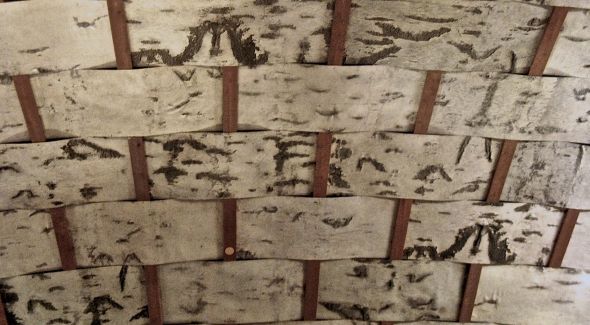
Starting off with boundaries and lures, I’m drawn right away to what is being done in encasement. With the opening line, I’m already excited that there’s a politics here in ordering, segregating, foregrounding (or not). And, yes, the text offers up generative boundary-makings in its casino evocations: representational/immersive, intimate/general, secret/public, attuned/distracted. But it never becomes clear to me how the breachings and blurrings of these boundaries through cases and gaming spaces relate to the “cases” of method, of reading and writing practices, of tracing the tos and fros of subjects and place- or space-makings, of critical curatorial insights. It is as if boundaries, blurrings, and lures are merely being indexed and, as I read through, I keep asking “what for?”—especially when something like a politics surfaces in the text (for example the “selective strategy” that invisibilizes histories of displacement and dispossession).
This isn’t to the detriment of the text, I get what I want at the end: I learn that what I am reading about is a reading and writing practice centered on sensory engagement and not a text that wants to press into whatever containments or openings are done in the boundary-making practices of cases. In this sense I wonder if the language of “boundaries,” “ordered spaces,” or “partition” is misleading as an introduction. Really, isn’t it about how histories, fabulations, natures/materialities, sensory cues, circulation strategies, etc. are multiply held-together in both the space of the Mohegan Sun and in this textual and photographic intervention?
I can see that the photos offer up “Mohegan symbols” and “distracting interiors.” Without captions, I have no context for what I’m looking at (much like a casino-goer): what is a stylized design element, what is Mohegan cosmology? I found this strategic unlinking very helpful for imagining what is being held together in the space of sensory engagement at Mohegan Sun.
As I read through, I get the sense (and maybe I’m wrong) that Mohegan histories and knowledges as they show up in the casino are represented in this text as a kind of burlesque of “real” Mohegan tribal practices. As if the symbols and stories are displaced or somehow made-deficient in being placed-casinowise.
But if casino spaces really are continuous with “traditional” exhibition spaces as you go on to suggest, this doesn’t hold. In a gallery space, Indigenous self-representations are generally appraised as sovereignty-making acts of fierce resistance, revitalization, and resurgence. How is a casino on the same continuum if Indigenous self-representations are considered in this “case” to be stylizations or imaginings of a “particular kind of nowhere?”
Some copy-editing suggestions:
We choose this site because it… (to avoid repetition of “case” and the unwieldy “case of focus”)
“The absence … seeks to erase the outside” (it doesn’t really erase the outside), or “suspends time and space”
I think the “particular kind of nowhere” might benefit from a brief nod to Marc Augé’s work on “non-places”, a “space which cannot be defined as relational, or historical, or con-cerned with identity” (2008, 64). Since you then describe the casino as a “site for longing” and “a sense of place specifically connected to..” this might provide for an opportune moment to expand/challenge Augé. Just a thought.
I don’t quite understand what you mean by “local imagined identities” – imagined by whom? And imagined in contrast to live and real? Also, please detail what/who “tribal historians” are. Is this your designation?
Details on the design process would be good: who commissioned, how was it done, etc. Just to get a sense of power vectors involved.
Would be interesting to reference natural history museum displays (dioramas) here – Donna Haraway’s Teddy Bear Patriarchy comes to mind. Also, could make a more complex/complicated/troubling argument about inside/outside – especially since it’s not clear what the “outside” is.
Copy-editing: Last sentence is repetition. Cut.
[whisper (or not) secret (or not) stories ]
I’m not sure I understand the meaning: does it whisper or scream secret or public stories? Or does it whisper or silence? And what would be the “secret” stories? The ones not intelligible wihtout the purchased guide book?
Again, not entirely sure about the use of “imagined”. Also, what do you mean by “groundings”?
I think rhetorically it is nice to make a case for secrets and silences amidst the blaring jumble of the casino, particularly in relation to the encasements and boundaries of museum displays introduced in §1. But that doesn’t mean that mess and order, diversity and homogeneity, the corporate and the indigenous can be easily mapped and are mutually exclusive. For example, the dioramas here at the natural history museum (Berlin) seem perfectly still and congruent and life-like (scientifically accurate) but this appearance betrays many inventive compromises, interets and negotiations, and really rather incommensurable modes of orderings.
I agree with Mathew that the images require captions. In addition it might be nice to give them space on the page to somewhat re-enact the immersion. So maybe reproduce full-bleed and include explanations (perhaps even quotes from the guide).